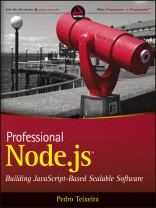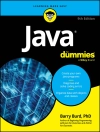Learn to build fast and scalable software in Java Script with Node.js
Node.js is a powerful and popular new framework for writing scalable network programs using Java Script. This no nonsense book begins with an overview of Node.js and then quickly dives into the code, core concepts, and APIs. In-depth coverage pares down the essentials to cover debugging, unit testing, and flow control so that you can start building and testing your own modules right away.
- Covers node and asynchronous programming main concepts
- Addresses the basics: modules, buffers, events, and timers
- Explores streams, file systems, networking, and automated unit testing
- Goes beyond the basics, and shares techniques and tools for debugging, unit testing, and flow control
If you already know Java Script and are curious about the power of Node.js, then this is the ideal book for you.
Tabla de materias
INTRODUCTION xxvii
PART I: INTRODUCTION AND SETUP
CHAPTER 1: INSTALLING NODE 3
Installing Node on Windows 4
Installing on Mac OS X 5
Installing Node Using the Source Code 6
Choosing the Node Version 6
Downloading the Node Source Code 6
Building Node 7
Installing Node 7
Running Node 8
Setting Up and Using Node Package Manager 8
Using NPM to Install, Update, and Uninstall Packages 9
Summary 13
CHAPTER 2: INTRODUCING NODE 15
Introducing the Event-Driven Programming Style 16
How Node and Java Script Make Writing Asynchronous Applications Easier 17
What Are Closures? 18
How Closures Help When Programming Asynchronously 19
Summary 19
PART II: NODE CORE API BASICS
CHAPTER 3: LOADING MODULES 23
Understanding How Node Loads Modules 24
Exporting a Module 24
Loading a Module 25
Summary 28
CHAPTER 4: USING BUFFERS TO MANIPULATE, ENCODE, AND DECODE BINARY DATA 29
Creating a Buffer 30
Getting and Setting Bytes in a Buffer 30
Slicing a Buffer 32
Copying a Buffer 32
Decoding a Buffer 32
Summary 33
CHAPTER 5: USING THE EVENT EMITTER PATTERN TO SIMPLIFY EVENT BINDING 35
Understanding the Standard Callback Pattern 36
Understanding the Event Emitter Pattern 36
Understanding Event Types 37
Using the Event Emitter API 38
Binding Callbacks Using .add Listener() or .on() 38
Binding Multiple Event Listeners 39
Removing an Event Listener from an Event Emitter
Using .remove Listener() 40
Getting a Callback Executed at Most Once Using .once() 40
Removing All Event Listeners from an Event Emitter Using .remove All Listeners() 41
Creating an Event Emitter 41
Inheriting from Node Event Emitter 42
Emitting Events 42
Summary 43
CHAPTER 6: SCHEDULING THE EXECUTION OF FUNCTIONS USING TIMERS 45
Using set Timeout to Defer the Execution of a Function 46
Using clear Timeout to Cancel the Execution of a Function 46
Scheduling and Canceling the Repetitive Execution of a Function 47
Using process.next Tick to Defer the Execution of a Function Until the Next Event Loop Iteration 47
Blocking the Event Loop 48
Escaping the Event Loop 49
Using set Timeout Instead of set Interval to Force Serialization 49
Summary 50
PART III: FILES, PROCESSES, STREAMS, AND NETWORKING
CHAPTER 7: QUERYING, READING FROM, AND WRITING TO FILES 53
Manipulating File Paths 54
Normalizing Paths 54
Joining Paths 54
Resolving Paths 55
Finding the Relative Path Between Two Absolute Paths 55
Extracting Components of a Path 55
Determining the Existence of a Path 56
Introducing the fs Module 57
Querying File Statistics 57
Opening a File 58
Reading from a File 59
Writing to a File 60
Closing a File 60
Summary 62
CHAPTER 8: CREATING AND CONTROLLING EXTERNAL PROCESSES 63
Executing External Commands 64
Spawning Child Processes 69
Creating the Child Process 69
Listening for Data from the Child Process 69
Sending Data to the Child Process 70
Receiving Notification When the Child Process Exits 72
Signaling and Killing Processes 73
Summary 74
CHAPTER 9: READING AND WRITING STREAMS OF DATA 75
Using a Readable Stream 76
Waiting for Data 76
Pausing and Resuming a Stream 77
Knowing When the Stream Ends 77
Using Writable Streams 77
Writing Data into a Stream 78
Waiting for a Stream to Drain 78
Considering Some Stream Examples 78
Creating File-System Streams 79
Understanding Networking Streams 80
Avoiding the Slow Client Problem and Saving Your Server 80
Understanding the Slow Client Problem 80
Avoiding the Slow Client Problem 81
Using stream.pipe() to Prevent the Slow Client Problem and Assembling Readable and Writable Streams Using pipe() 82
Summary 82
CHAPTER 10: BUILDING TCP SERVERS 83
Creating a TCP Server 83
Using the Socket Object 85
Understanding Idle Sockets 86
Setting Up Keep-Alive 87
Using Delay or No Delay 87
Listening for Client Connections 88
Closing the Server 88
Handling Errors 88
Building a Simple TCP Chat Server 89
Accepting Connections 89
Reading Data from a Connection 90
Collecting All the Clients 90
Broadcasting Data 91
Removing Closed Connections 92
Using Your TCP Chat Server 93
Summary 93
CHAPTER 11: BUILDING HTTP SERVERS 95
Understanding the http.Server Request Object 97
Understanding the http.Server Response Object 98
Writing a Header 98
Changing or Setting a Header 99
Removing a Header 99
Writing a Piece of the Response Body 99
Streaming HTTP Chunked Responses 99
Piping a File 100
Piping the Output of Another Process 100
Shutting Down the Server 101
Example 1: Building a Server that Serves Static Files 101
Example 2: Making Use of HTTP Chunked Responses and Timers 102
Summary 102
CHAPTER 12: BUILDING A TCP CLIENT 103
Connecting to a Server 104
Sending and Receiving Data 105
Ending the Connection 105
Handling Errors 106
Building an Example Command-Line TCP Client 106
Connecting to the Server 107
Sending the Command Line to the Server 107
Printing Server Messages 107
Reconnecting if the Connection Dies 108
Closing the Connection 109
Putting the Client Together 111
Summary 112
CHAPTER 13: MAKING HTTP REQUESTS 113
Making GET Requests 113
Using Other HTTP Verbs 114
Inspecting the Response Object 115
Obtaining the Response Body 116
Streaming the Response Body 116
Pooling Sockets Using http.Agent 116
Using a Third-Party Request Module to Simplify HTTP Requests 118
Installing and Using Request 118
Creating a Testing Server 120
Following Redirects 121
Setting Some Request Options 123
Encoding the Request Body 125
Streaming 127
Using a Cookie Jar 127
Summary 128
CHAPTER 14: USING DATAGRAMS (UDP) 129
Understanding UDP 129
Understanding the Uses of UDP 130
Building a Datagram Server 130
Listening for Messages 130
Testing the Server 131
Inspecting Additional Message Information 132
Creating a Simple Datagram Echo Server 132
Waiting for Messages 132
Sending Messages Back to Senders 132
Putting the Echo Server Together 133
Building a Datagram Client 134
Creating the Client 134
Sending Messages 134
Closing the Socket 134
Creating a Simple Datagram Command-Line Client 135
Reading from the Command Line 135
Sending Data to the Server 135
Receiving Data from the Server 136
Putting the Command-Line UDP Client Together 136
Understanding and Using Datagram Multicast 136
Receiving Multicast Messages 137
Sending Multicast Messages 138
Understanding Maximum Datagram Size 138
Summary 138
CHAPTER 15: SECURING YOUR TCP SERVER WITH TLS/SSL 139
Understanding Private and Public Keys 139
Generating a Private Key 140
Generating a Public Key 140
Building a TLS Server 141
Initializing the Server 141
Listening for Connections 141
Reading Data from the Client 142
Sending Data to the Client 142
Ending the Connection 142
Building a TLS Client 143
Initializing the Client 143
Connecting to the Server 143
Verifying the Server Certificate 143
Sending Data to the Server 144
Reading Data from the Server 144
Ending the Connection 144
Building Some Examples 145
Creating a TLS Chat Server 145
Creating a TLS Command-Line Chat Client 146
Verifying the Client Certificate 147
Summary 148
CHAPTER 16: SECURING YOUR HTTP SERVER WITH HTTPS 149
Building a Secure HTTP Server 149
Setting Up the Server Options 150
Listening for Connections 150
Validating the HTTPS Client Certificate 151
Creating an HTTPS Client 152
Initializing the Client 152
Making the Request 152
Validating the HTTPS Server Certificate 153
Summary 154
PART IV: BUILDING AND DEBUGGING MODULES AND APPLICATIONS
CHAPTER 17: TESTING MODULES AND APPLICATIONS 157
Using a Test Runner 157
Writing Tests 158
Running Tests 159
Using an Assertion Testing Module 159
Using the assert Module 159
Using the Built-in Assertion Functions in Node-Tap 161
Testing Your Asynchronous Module 163
Summary 166
CHAPTER 18: DEBUGGING MODULES AND APPLICATIONS 167
Using console.log 167
Using Node’s Built-in Debugger 169
Using Node Inspector 173
Summary 175
CHAPTER 19: CONTROLLING THE CALLBACK FLOW 177
Understanding the Boomerang Effect 177
Avoiding the Boomerang Effect
by Declaring Functions 179
Using the async Flow Control Library 183
Executing in Series 184
Executing in Parallel 185
Cascading 186
Queuing 187
Iterating 189
Mapping 190
Reducing 191
Filtering 192
Detecting 193
Summary 194
PART V: BUILDING WEB APPLICATIONS
CHAPTER 20: BUILDING AND USING HTTP MIDDLEWARE 197
Understanding the Connect HTTP Middleware Framework 198
Building Your Own HTTP Middleware 198
Creating Asynchronous Middleware 200
Registering Callbacks Inside Middleware 201
Handling Errors Inside Middleware 203
Using the HTTP Middleware Bundled in Connect 206
Logging Requests 206
Handling Errors 208
Serving Static Files 209
Parsing the Query String 210
Parsing the Request Body 211
Parsing Cookies 212
Using a Session 213
Other Available Middleware 216
Summary 216
CHAPTER 21: MAKING A WEB APPLICATION USING EXPRESS.JS 217
Initializing Your Express.js Application 218
Setting Up Middleware in Your Application 220
Routing Requests 222
Handling Routes 222
Using Sessions 229
Using Route Middleware 234
Summary 238
CHAPTER 22: MAKING UNIVERSAL REAL-TIME WEB APPLICATIONS USING SOCKET.IO 241
Understanding How Web Sockets Work 242
Using Socket.IO to Build Web Socket Applications 243
Installing and Running Socket.IO on the Server 243
Building a Real-Time Web Chat with Socket.IO 245
Extending the Chat Application 250
Detecting Disconnections 254
Separating Users into Rooms 255
Using Namespaces 259
Distributing the Server-Side Application Using Redis 259
Summary 263
PART VI: CONNECTING TO DATABASES
CHAPTER 23: CONNECTING TO MYSQL USING NODE-MYSQL 267
Using a Library to Connect to and Communicate
with a My SQL Database 268
Adding Data to the Database with
Security Concerns in Mind 270
Reading Data Effi ciently 272
Summary 276
CHAPTER 24: CONNECTING TO COUCHDB USING NANO 277
Installing Nano 278
Connecting and Creating a Database 281
Storing Documents 285
Creating and Using Couch DB Views 286
Attaching Files to a Couch DB Document 298
Summary 310
CHAPTER 25: CONNECTING TO MONGODB USING MONGOOSE 311
Installing Mongoose 313
Understanding How Mongoose Uses Models to Encapsulate Database Access 313
Connecting to Mongo DB 314
Defining a Schema 314
Defining a Model 315
Using Validators 324
Using Modifiers 330
Using Getters 331
Using Virtual Attributes 332
Using Default Values 338
Defining Indexes 340
Referencing Other Documents Using DB Refs 341
Defining Instance Methods 347
Defining Static Methods 348
Summary 349
INDEX 351
Sobre el autor
Pedro Teixeira is a prolific open-source programmer and author of many Node.js modules. He is a founding partner of The Node Firm and a senior programmer at Nodejitsu Inc., the leading Node.js platform-as-a-service provider. He is also the author of the popular Node Tuts screencasts.
Wrox Professional guides are planned and written by working programmers to meet the real-world needs of programmers, developers, and IT professionals. Focused and relevant, they address the issues technology professionals face every day. They provide examples, practical solutions, and expert education in new technologies, all designed to help programmers do a better job.











